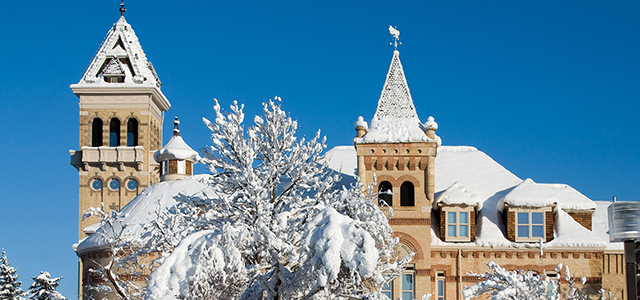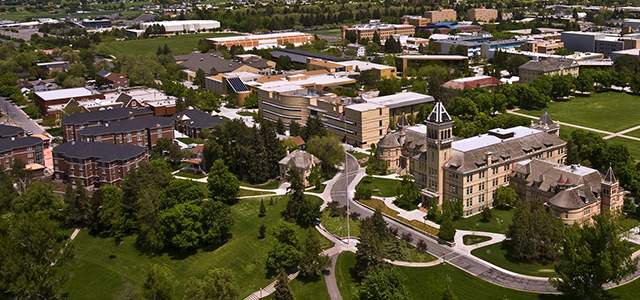Speakers
Maura Hagan
Dean of the Utah State University College of Science and professor of Physics in the USU Department of Physics
Dean of the Utah State University College of Science and professor of Physics in the USU Department of Physics

Maura Hagan was awarded a B.A. in physics from Emmanuel College in 1975, and both M.S. and Ph.D. degrees in physics from Boston College in 1980 and 1986, respectively. Between 1986 and 1992, she was a staff member at Massachusetts Institute of Technology Haystack Observatory. She joined the staff of the National Center for Atmospheric Research High Altitude Observatory (NCAR/HAO) in 1992 and was promoted to Senior Scientist in 2003. During the past ten years Maura served as the Director of the NCAR Advanced Study Program (2005-2010), NCAR Deputy Director (2008-2013), and NCAR Interim Director (2013). In 2015 she became the Dean of College of Science and Professor of Physics at Utah State University.
Maura's research interests are centered on investigations of the mesosphere, thermosphere and ionosphere with emphases on the coupling between these atmospheric regions and the generation and propagation of tides and planetary waves therein as well as in regions below. She has authored or co-authored more than 100 refereed publications and is a Fellow of the American Meteorological Society (AMS) and the American Geophysical Union (AGU).
Maura's research interests are centered on investigations of the mesosphere, thermosphere and ionosphere with emphases on the coupling between these atmospheric regions and the generation and propagation of tides and planetary waves therein as well as in regions below. She has authored or co-authored more than 100 refereed publications and is a Fellow of the American Meteorological Society (AMS) and the American Geophysical Union (AGU).
Sherry Towers
Research professor at the Simon A. Levin Mathematical, Computational, and Modeling Sciences Center at Arizona State University
Research professor at the Simon A. Levin Mathematical, Computational, and Modeling Sciences Center at Arizona State University
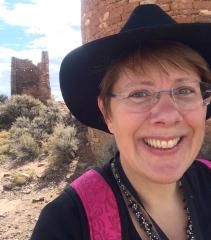
Dr Towers has a diverse background in physics, mathematical and computational modeling, applied statistics, advanced quantitative methods, high performance computing, and data mining. She has over 360 publications on a wide variety of topics from physics to the life and social sciences, and her unique trans-disciplinary skill set enables her to examine a wide range of research questions that are often of broad interest and importance to policy makers and the general public.
Her diverse research interests include modeling the spread of disease in populations, and also the application of contagion models to examine the spread of ideas and social behaviors within a population. Several of her publications in epidemiology have received widespread media attention, including forecasts for the progression of the 2009 influenza pandemic, and the 2014 ebola epidemic in West Africa.
Her work in computational sociology has also received international media attention, including an analysis of how media can incite panic in a population, and how contagion may play a role in the temporal patterns observed in mass killings in the US. The latter work has received extensive ongoing international media coverage, and was also profiled in 2017 in the "Morgan Freeman's Through the Wormhole" documentary series on the Discovery Channel: "Is Gun Crime a Virus?".
She also continues to publish papers in the field of physics.
Since 2012, she has been a Research Professor with the Simon A. Levin Mathematical and Computational Modeling Sciences Center at Arizona State University.
Her diverse research interests include modeling the spread of disease in populations, and also the application of contagion models to examine the spread of ideas and social behaviors within a population. Several of her publications in epidemiology have received widespread media attention, including forecasts for the progression of the 2009 influenza pandemic, and the 2014 ebola epidemic in West Africa.
Her work in computational sociology has also received international media attention, including an analysis of how media can incite panic in a population, and how contagion may play a role in the temporal patterns observed in mass killings in the US. The latter work has received extensive ongoing international media coverage, and was also profiled in 2017 in the "Morgan Freeman's Through the Wormhole" documentary series on the Discovery Channel: "Is Gun Crime a Virus?".
She also continues to publish papers in the field of physics.
Since 2012, she has been a Research Professor with the Simon A. Levin Mathematical and Computational Modeling Sciences Center at Arizona State University.
Fabiola Gianotti - Keynote Speaker (Web-cast)
Director-General of CERN
Director-General of CERN

Fabiola Gianotti is the Keynote Speaker for the 2019 CUWiP conferences. She received a Ph.D. in experimental particle physics from the University of Milan in 1989. Since 1994 she has been a research physicist at CERN, the European Organisation for Nuclear Research, working on detector development and construction, software development, and data analysis. From 2009 to 2013 she led the ATLAS collaboration of 3000 physicists, and in 2012 she presented the ATLAS results on the Higgs boson search and discovery. Her awards include several honorary degrees, the Special Breakthrough Prize in Fundamental Physics, and the Enrico Fermi Prize of the Italian Physical Society. In 2016 she became Director-General of CERN, the first woman to hold that position. (photo credit: CERN)
Kate Kirby
Chief Executive Officer at American Physical Society (APS Physics)
Chief Executive Officer at American Physical Society (APS Physics)
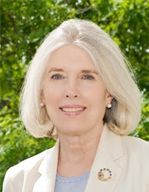
Dr. Kirby received her A.B. in Chemistry and Physics from Harvard/Radcliffe College in 1967 and her Ph.D. from the University of Chicago in 1972.
After a postdoctoral fellowship at the Harvard College Observatory (1972-73), she was appointed as research physicist at the Smithsonian Astrophysical Observatory and Lecturer in the Harvard University Department of Astronomy (1973-86, and 2003 - present). From 1988 to 2001 she served as an Associate Director at the Harvard-Smithsonian Center for Astrophysics, heading the Atomic and Molecular Physics Division. In 2001 she was appointed Director of the NSF-funded Institute for Theoretical Atomic, Molecular and Optical Physics (ITAMP) at Harvard and Smithsonian. Since 2009 she has been the Executive Officer for the American Physical Society.
Dr. Kirby's research interests lie in the area of theoretical atomic and molecular physics, particularly focusing on the calculation of atomic and molecular processes important in astrophysics and atmospheric physics. Recent work has included studies of collision-broadened alkali atom resonance lines (seen in the atmospheres of brown dwarf stars), electron impact excitation of highly-charged ions (to understand astrophysical x-ray spectra), molecular line opacities in cool stellar atmospheres, and formation and destruction of small molecules in astrophysical environments. In addition, she is working on processes for forming ultracold polar molecules via laser-induced photoassociation and using such systems as a platform for robust quantum computation. In 1990 she was elected to Fellowship in the APS.
Dr. Kirby has both chaired and served on numerous committees of the American Physical Society, including the Fellowship Committee (1993- 95), the Nominating Committee (1994-96), the APS Ethics Task Force (2002-2003), the Committee on Prizes and Awards (2005-2006), and the Search Committee for APS Leadership positions (Editor-in-Chief and Treasurer, 2005-06). She was elected APS councilor-at-large (1991-93) and Divisional Councilor for DAMOP (2003-07) and elected to the Executive Board of APS (2005-06). In addition she has served as Vice-Chair, Chair-Elect, and Chair of DAMOP (1995-98). Other activities include membership on the Basic Energy Sciences Advisory Committee (2003-2008) and co-chair of the BESAC Subcommittee on Theory and Computation, member of the NAS/NRC Decadal Assessment Committee for Atomic, Molecular and Optical Science (AMO2010), Chair of the International Conference on Photonic, Electronic, and Atomic Collisions (2001-2003), and member of the Editorial Board of Reports on Progress in Physics (2007 - present).
After a postdoctoral fellowship at the Harvard College Observatory (1972-73), she was appointed as research physicist at the Smithsonian Astrophysical Observatory and Lecturer in the Harvard University Department of Astronomy (1973-86, and 2003 - present). From 1988 to 2001 she served as an Associate Director at the Harvard-Smithsonian Center for Astrophysics, heading the Atomic and Molecular Physics Division. In 2001 she was appointed Director of the NSF-funded Institute for Theoretical Atomic, Molecular and Optical Physics (ITAMP) at Harvard and Smithsonian. Since 2009 she has been the Executive Officer for the American Physical Society.
Dr. Kirby's research interests lie in the area of theoretical atomic and molecular physics, particularly focusing on the calculation of atomic and molecular processes important in astrophysics and atmospheric physics. Recent work has included studies of collision-broadened alkali atom resonance lines (seen in the atmospheres of brown dwarf stars), electron impact excitation of highly-charged ions (to understand astrophysical x-ray spectra), molecular line opacities in cool stellar atmospheres, and formation and destruction of small molecules in astrophysical environments. In addition, she is working on processes for forming ultracold polar molecules via laser-induced photoassociation and using such systems as a platform for robust quantum computation. In 1990 she was elected to Fellowship in the APS.
Dr. Kirby has both chaired and served on numerous committees of the American Physical Society, including the Fellowship Committee (1993- 95), the Nominating Committee (1994-96), the APS Ethics Task Force (2002-2003), the Committee on Prizes and Awards (2005-2006), and the Search Committee for APS Leadership positions (Editor-in-Chief and Treasurer, 2005-06). She was elected APS councilor-at-large (1991-93) and Divisional Councilor for DAMOP (2003-07) and elected to the Executive Board of APS (2005-06). In addition she has served as Vice-Chair, Chair-Elect, and Chair of DAMOP (1995-98). Other activities include membership on the Basic Energy Sciences Advisory Committee (2003-2008) and co-chair of the BESAC Subcommittee on Theory and Computation, member of the NAS/NRC Decadal Assessment Committee for Atomic, Molecular and Optical Science (AMO2010), Chair of the International Conference on Photonic, Electronic, and Atomic Collisions (2001-2003), and member of the Editorial Board of Reports on Progress in Physics (2007 - present).
Christy Glass
USU Professor, Department of Sociology, Social Work and anthropology
Undergraduate Program Co-Director
USU Professor, Department of Sociology, Social Work and anthropology
Undergraduate Program Co-Director
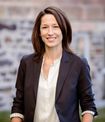
Dr. Christy Glass, an Associate Professor of Sociology, joined USU in 2005 after completing her Ph.D. at Yale University. Her research falls into two broad areas that span multiple disciplines, including sociology, gender studies, management and business: (1) the challenges women and minority leaders face in the U.S.; and (2) the impact of gender on professional mobility in the U.S. and Europe.
To date she published over forty peer-reviewed journal articles and book chapters that have been cited over 440 times on topics ranging from leadership diversity and organizational management to recruitment, hiring and employment discrimination.
Dr. Glass' work has appeared in top journals in sociology and management, including Social Forces, Work & Occupations, Gender & Society, Strategic Management Journal, and Business Strategy & the Environment.
Her research has also been featured in The New York Times, The Guardian, National Public Radio, Huffington Post, CNN, and the Harvard Business Review. Her work has been featured by a number of national organizations, including Catalyst, the U.S. Chamber of Commerce, and the American Bar Association. In 2014 and 2015 her work was cited in multiple amici curiae briefs filed with the U.S. Supreme Court.
To date she published over forty peer-reviewed journal articles and book chapters that have been cited over 440 times on topics ranging from leadership diversity and organizational management to recruitment, hiring and employment discrimination.
Dr. Glass' work has appeared in top journals in sociology and management, including Social Forces, Work & Occupations, Gender & Society, Strategic Management Journal, and Business Strategy & the Environment.
Her research has also been featured in The New York Times, The Guardian, National Public Radio, Huffington Post, CNN, and the Harvard Business Review. Her work has been featured by a number of national organizations, including Catalyst, the U.S. Chamber of Commerce, and the American Bar Association. In 2014 and 2015 her work was cited in multiple amici curiae briefs filed with the U.S. Supreme Court.
Maria J. Rodriguez
Professor, Utah State University, IFT/CSIC and Max Planck Institute for Gravitational Physics
Professor, Utah State University, IFT/CSIC and Max Planck Institute for Gravitational Physics
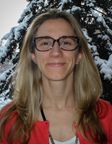
Dr. Maria J. Rodriguez studied physics in La Plata (Argentina), Santa Barbara (USA) and Barcelona (Spain). During her PhD at the Universidad de Barcelona she investigated black hole solutions of General Relativity (GR) in more than four dimensions. As a visiting graduate fellow at the University of California in Santa Barbara, she discovered the so-called bicycling black ring solutions in GR. After her doctoral degree in 2008 she took subsequent postdoctoral positions at the Max Planck Institute for Gravitational Physics - Albert Einstein Institute (2008-2011), Germany; CEA/Saclay, France, and Harvard University, USA (2011-2015). At Harvard, she worked on theoretical aspects of black hole physics as well as models of energy extraction from black holes. She is currently an Assistant Professor of Physics at Utah State University and holds research appointments at Instituto de Física Teórica, Spain and Max Planck Institute for Gravitational Physics.
Dr. Rodriguez's research aims to improve our understanding of space-time, quantum gravity and in particular black holes. Her projects deal with the largest events recorded by mankind, highly energetic jets, and the most elemental areas of space-time, event horizons of black holes. The ultimate purpose of Dr Rodriguez's research is to deepen our understanding about energy extraction from black holes, holography and our four-dimensional reality. Dr. Rodriguez has collaborated with some of the world leaders in the field, including Roberto Emparan (Barcelona), Ted Jacobson (Maryland), Lisa Randall (Harvard), Andrew Strominger (Harvard) or Malcolm Perry (Cambridge, UK). Her research has been consistently funded by prestigious awards from the European Union, Spanish Government, the Max Planck Society and National Science Foundation.
Dr. Rodriguez's research aims to improve our understanding of space-time, quantum gravity and in particular black holes. Her projects deal with the largest events recorded by mankind, highly energetic jets, and the most elemental areas of space-time, event horizons of black holes. The ultimate purpose of Dr Rodriguez's research is to deepen our understanding about energy extraction from black holes, holography and our four-dimensional reality. Dr. Rodriguez has collaborated with some of the world leaders in the field, including Roberto Emparan (Barcelona), Ted Jacobson (Maryland), Lisa Randall (Harvard), Andrew Strominger (Harvard) or Malcolm Perry (Cambridge, UK). Her research has been consistently funded by prestigious awards from the European Union, Spanish Government, the Max Planck Society and National Science Foundation.




